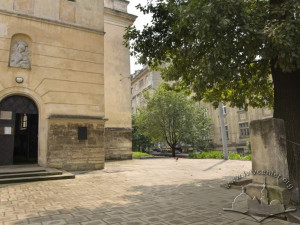
Vul. Zamarstynivska, 9 – former church of the Holy Cross ID: 199
Former Church of the Holy Cross (currently the building of the Lviv Institute of Internal Affairs) with the adjacent buildings the former monastery is located on a territory between the present Zamarstynivska Street and Chornovola Boulevard. It was built on the territory of the northern district, outside of the early modern defensive city walls, and was an example of a fortified church located in the outlying district of the city. Its construction dates back to the 1630s, followed by 1744 reconstruction (by the architect Bernard Meretini / Meretyn), and over the course of the nineteenth and the twentieth centuries the church remains a monument of sacral architecture of the late Renaissance period which has preserved specific Gothic elements.
